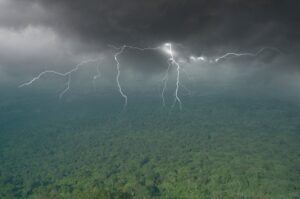A passion for the natural world drives many of our adventures. And when we’re not outside, we love delving into the discoveries about the places we live and travel. Here are some of the best natural history links we’ve found this week.
Mega-sanctuary needed
Protection for gray wolves, beavers: A group of researchers has proposed a sanctuary for gray wolves and other keystone species in America. The Western Rewilding Network project has sketched out a protected area of 496,000 sq km across 11 Western states.
They argue that species such as gray wolves and beavers are essential for ecosystem health. Wolves control the number of ungulates, which helps many plant species regrow. Proposed regions within the mega-sanctuary include Yellowstone National Park, the Northern and Southern Rockies, and the Mogollon Plateau.
‘Goatelope’ mummy found in melting glacier: Glaciologist Andrea Fischer has found a mummified chamois in Austria. The chamois is a goat-antelope relative, native to the mountains of Europe. The mummified remains are of a young female kid and are around 500 years old.
Fischer and her team stumbled across the frozen remains while studying the ice. “It’s incredible that she’s sitting exactly where we do our research and that we passed by right when it came out of the ice,” says Fischer.
“With the melting of the glaciers, there should be more of these finds, maybe also other humans showing up in the ice. Actually, it’s quite likely,” says Albert Zink, head of the institute for mummy studies at Eurac Research.

Mice threaten albatross populations. Photo: Shutterstock
Of mice and albatrosses
Another invasive species runs amok: Gough Island is an important breeding ground for albatrosses. Two hundred years ago, seal hunters introduced mice to the small island, which lies in the South Atlantic, midway between Argentina and South Africa. The invasive species decreased the supply of seeds and insects on the island, then started eating seabird eggs and chicks. Some even attacked adult birds.
Last year, conservationists dropped poisoned mouse bait all over the island to try and cull the mice and protect the seabirds. But despite their efforts, mice are still multiplying.
The number of breeding pairs of albatross on the island has actually remained relatively stable, but their chicks aren’t surviving the mice attacks. As the established breeding pairs age, few new pairs are replacing them. Observers have noted similar patterns with other bird species on the island.
Though the mouse poison did lead to a higher breeding success rate this year, more needs to be done to eradicate the mice.
The mysterious dance of cricket embryos: Embryos have long intrigued geneticist Cassandra Extavour. Specifically, she wants to know how embryonic cells know what to do and where to go. To look at this more closely, Extavour has been studying crickets.
In humans, a single cell starts to divide into other cells. In crickets, just the nucleus of the cell divides. These nuclei later travel in a mysterious but non-random way through shared cytoplasm to form cellular membranes.
After hours of watching footage of the embryo and looking for patterns, the team called in mathematician Christopher Rycroft. With his help, they discovered that geometry controlled the movement of these cells and not chemical or other signals.

Gorillas can learn new sounds. Photo: Shutterstock
Gorillas learn a new noise to attract attention
Captive gorillas can learn to make new noises: Gorillas sometimes make a sound somewhere between a cough and a sneeze. Roberta Salmi, a biological anthropologist, noticed the new sound when she was visiting a zoo. The gorillas only made this sound when zookeepers were nearby with food.
Salmi studied the behavior across 20 zoos in the United States and Canada. Zoo gorillas use the “snough” noise to get the keeper’s attention. Researchers have not heard this vocalization in the wild. This suggests that captive apes learned to make this sound in their current unnatural environment. This ability is quite rare among animals.
The snoughing noise only occurred when keepers were holding food. The gorillas likely discovered that the sound prompted a response. They never directed this noise toward other apes, only toward humans.
Heat waves shrinking UK rivers
Wildlife under stress as dry spell shrinks rivers: Across the UK, temperatures are soaring. The long dry spell is starting to severely impact wildlife.
Chalk streams are home to many species, including salmon, otters, and kingfishers. Only 200 chalk streams exist worldwide and 85 percent are in southern and eastern England.
“This is our Barrier Reef or our Amazon rainforest,” Christine Colvin of the Rivers Trust explained.
The water levels in many of these streams are rapidly decreasing, and some small streams have dried up completely. Low river flow also affects food sources for fish and invertebrates as well as having a knock-on effect on animals further up the food chain.
Water companies are imposing hosepipe bans to try and improve the situation. But companies may need to completely rethink how we use water. “We want to see government and the water companies responding in a coordinated way,” says Colvin.






